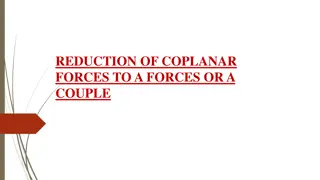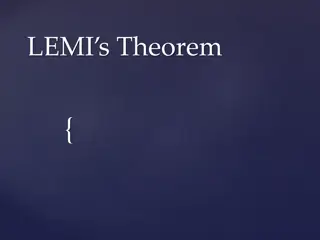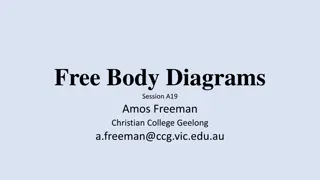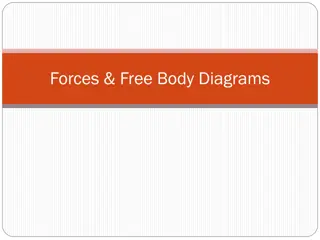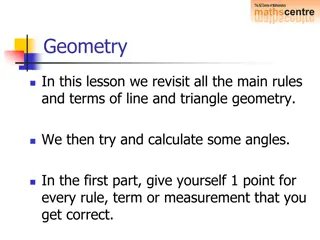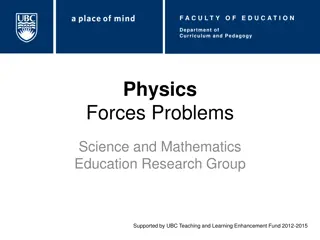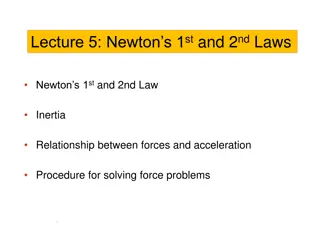Understanding Resolutions and Triangle of Forces in Physics
Resolutions of forces involve breaking down a force into components, while the Triangle of Forces explores how forces interact in equilibrium. By analyzing graphical and mathematical representations, you can determine the resultant force and its direction using trigonometric functions. Applying the laws of triangles helps in finding the magnitude and direction of the resultant force when multiple forces act at a point.
Download Presentation

Please find below an Image/Link to download the presentation.
The content on the website is provided AS IS for your information and personal use only. It may not be sold, licensed, or shared on other websites without obtaining consent from the author. Download presentation by click this link. If you encounter any issues during the download, it is possible that the publisher has removed the file from their server.
E N D
Presentation Transcript
Resolution of Forces: Fa F Fb Fig(a) Resolution of Forces
Graphically: Fig(b) Resolution of Forces
Fig(a) shows that the resultant force F divided into two components Fa and Fb are known as resolution of forces R. The separation of a single force or motion (cargo ship) into two or more which have different directions (tugboat A&B) are taken together are called resolution of forces R. Consider a force F represented by line OA making an angle with x-axis shown in fig (b). Draw a perpendicular AB on x-axis, According to head to tail rule OA is the resultant of vector represented by OB and BA. The components OB and AB are perpendicular to each other and they are rectangle component of each other. OB and AB represents its components Fx& Fy. Which component have attached angle is always component. Cosine
Mathematically: OA=OB+BA.. (1) Since (1) is written by: F=Fx+ Fy ...(2) Trigonometric functions: Fig(c) Trigonometric functions
Bb. Since: =cos B. .(3) Similarly: =sin .(4) By Pathegorous theorm: (6) ..(5)
Triangle of Forces: Fig(d) Triangle of Forces
When two forces meeting or passing through a point represented by two sides of a triangle in magnitude and direction taken in same order than closing side of triangle taken in the reverse order represents the resultant of the forces. Fig(d) shows that OA is a force that head is join to the tail of AB according to the head to tail rule but the resultant force is opposite and not follow the head to tail rule is called triangle law of forces. If magnitude of two forces is equal to the magnitude of the third force than the resultant is zero and they are in equilibrium. The resultant Vector R of the forces Vector P and Vector Q is the diagonal OB of the triangle. The magnitude of the resultant is: R = under root[ P2 + Q2 - 2PQcos ]
The direction of the resultant is: = sin-1[ Q / R sin ] Forces Vector P and Vector Q act at an angle . In order to find the resultant of Vector P and Vector Q, one can apply the head to tail method, to construct the triangle. The magnitude and the direction of Vector R can be found by using sine and cosine laws of triangles. If Vector P , Vector Q and Vector R are the three forces acting at a point and they are represented by the three sides of a triangle then P/OA =Q/AB =R/OB. If the angle is outside the triangle than we minus the into 180 degree. But if the angle is inside the triangle than we add into 180 degree.
Mathematically: OA=P OB=R AB=Q OAB AOB+ OAB+ OBA=180 +(180- )+ OBA=180 OBA=180- -180+ OBA= - According to Lami s theorm: When three coplanar, concurrent and non-colinear forces act on a body which is in equilibrium then the magnitude of each force is proportional to the sine of angle between other two forces.
Sine rule formula: P/sin( - ) = Q/sin = R/sin(180- ) P/sin( - ) = Q/sin = R/sin





